On August 3rd and 4th, the Seattle Department of Transportation (SDOT) held public open houses where they unveiled the 30% design for its Madison Street Bus Rapid Transit (BRT) project.
Identified in the 2012 Seattle Transit Master Plan as a priority corridor for High Capacity Transit and later designated as one of seven RapidRide+ lines, this new bus line will connect Downtown Seattle to Madison Valley via the First Hill and Capitol Hill neighborhoods. Utilizing a dedicated fleet of 60-foot electric trolley buses, this 2.4-mile route will feature six-minute frequency for most of the operational period as well as dedicated lanes along a majority of the route. The line will feature amenities such as real-time displays at stations and off-board payment at all stops.
Funding for this project is coming from the Move Seattle Levy, PSRC Mobility Grant, ST3 (if passed) as well as a Federal Transit Administration Small Starts Grant.
Public comment will be accepted online until August 16th and there will be one more public open house on tonight (August 9th) from 5pm to 7pm at the Meredith Mathews East Madison YMCA located at 1700 23rd Ave.
There have been a number of significant changes to the design since the the Locally Preferred Alternative (LPA) was approved by the Seattle City Council in February of 2016. With a few exceptions, the majority of changes will have a positive effect on the route. The use of exclusive transit lanes has increased to approximately 60% of the route, and the use of Business Access and Transit (BAT) lanes has decreased to only 4%.

Project Improvements
The Downtown segment of the route (west of I-5) has a number of obstacles, including garage access, the need to accommodate turns, and generally limited space. Wherever possible, the project has allocated space for transit-exclusive lanes with cars granted access to make right turns where necessary, at Second, Third, and Fourth Avenues.
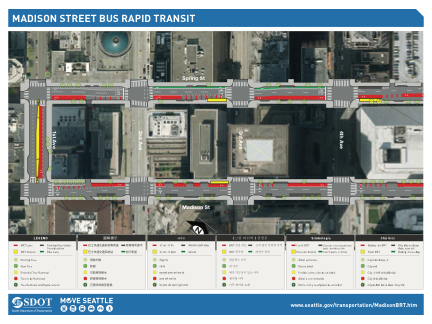
The westbound segment in Downtown will continue to utilize Madison Street, retaining the existing bus stop at Fifth Avenue near the Seattle Public Library. The current stop just west of Fourth Avenue, will be moved to the west side of Third Avenue to better connect to the Third Avenue bus lines. Wherever possible, the north curb lane on Madison Street will be bus only, with the exception of the intersections where right turns will be allowed.
The Madison bus line will share an island platform with the Center City Connector (CCC) Streetcar line, providing seamless connections as well as convenient access to the Federal Building, Coleman Dock Ferry Terminal, and other area businesses.
The eastbound segment away from Downtown on Spring Street will utilize a transit exclusive lane along the south curb of Spring Street. The improvements for the portion of Spring Street east of Third Avenue are being planned for early implementation so that the King County Metro Route 2 can take advantage of the performance improvements immediately, with further improvements to the bus stop amenities occurring closer to the start of service on the Madison Bus Rapid Transit line.
The design should allow buses on Spring Street to bypass traffic heading to Interstate 5 and will include a queue-jump traffic light to allow the buses to clear the intersection of Spring Street / Sixth Avenue first.
The Vehicles
The Madison RapidRide+ project will utilize a fleet of eight sixty-foot trolley buses, very similar to the brand new purple ones, with the addition of an extra set of doors on the driver’s side of the bus. These are needed to utilize the island platform bus stops located on First Ave, on First Hill, and on the Capitol Hill portions of the route. There will be no fare payment mechanism onboard, that functionality will be relegated to the stations themselves. While the Madison RapidRide+ line will be the first to feature these differences, it is highly likely that other Rapid Ride branded lines may adopt some or all of them in the future. Off-board payment will require the most amount of education and outreach, but ultimately will greatly expedite the boarding process.
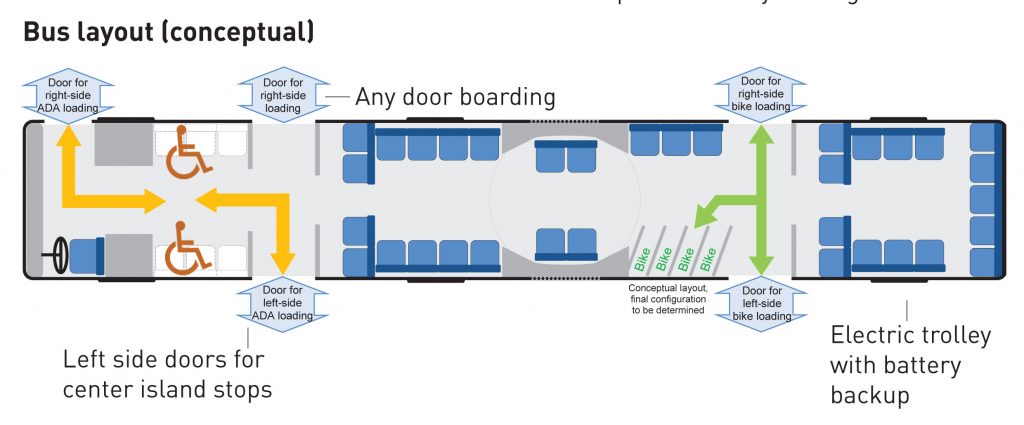
The new buses will make use of the new passive wheelchair restraint system that is currently available on the RapidRide B/C/D/E lines. This allows passengers in wheelchairs to position themselves without involving the driver, decreasing dwell time at stations.
In addition, the remaining space will prioritize standing room over seating. Internally the bus should feel closer to riding Link than a bus. Dual-sided doors by default remove a portion of the space that would otherwise contain seats. Regardless, SDOT and King County Metro’s analysis indicates that most rides are expected to be a short distance, and even if traveling from end-to-end the improvements to the right-of-way should shorten the time people will be required to stand.
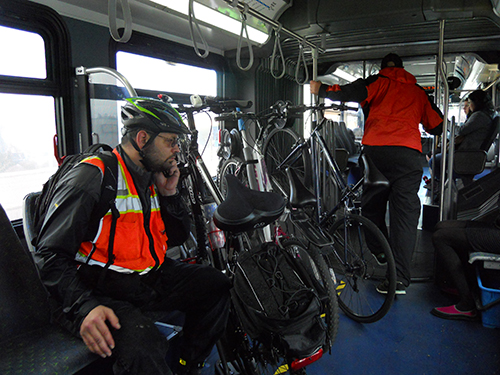
One important, new (for Metro) feature that is being proposed is the inclusion of four quick-load bike racks inside the new buses. This amenity was first unveiled as part of the 30% design open houses and would be a tremendous improvement over the existing exterior bike rack system currently employed in the greater Seattle area. The system would be similar, if not identical to that currently used on Community Transit’s Swift line. Moving the bike racks inside of the rear door vestibule will decrease dwell time and greatly improves the safety of bicyclists who wish to transport their bicycles. SDOT would like to include four bike positions located near the rear-door vestibule, with the ultimate intention of making transporting bikes of the bus as easy as it is on Link.
SDOT and Metro need to know that the amenity of internal bike racks is desired. Please send them feedback in support of this feature.
The Stations
The Madison RapidRide+ stations will feature all of the amenities currently available at most RapidRide bus stops. However, all fare payment for this line will be handled on the station platform (much like Link). This includes ORCA cards, cash, and tickets. Locations for wheelchair and bicycle loading will be etched into the platform surface to avoid confusion and conflict.
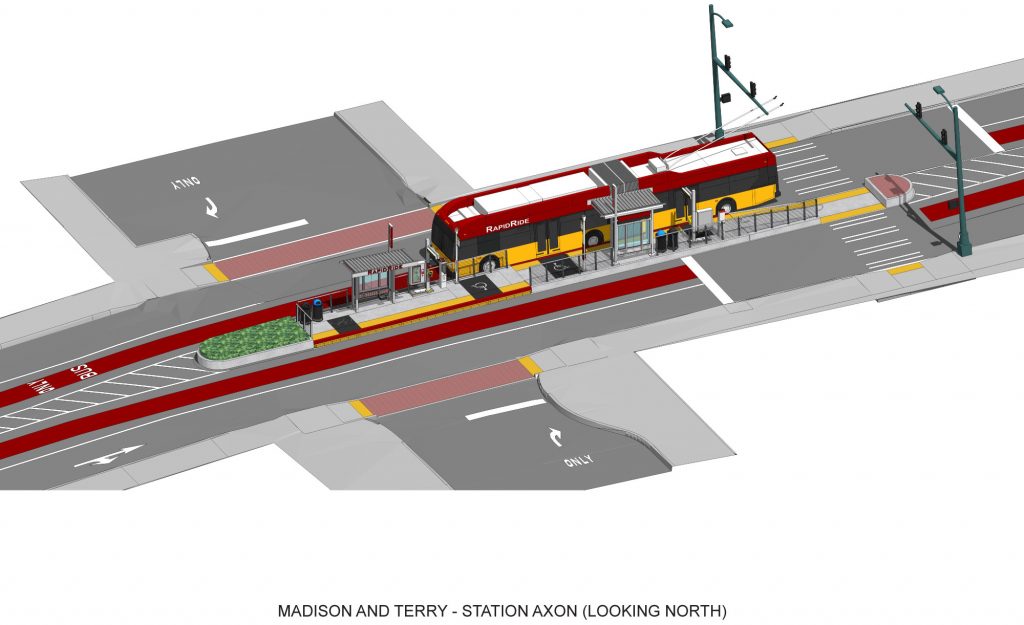
Station platforms will be full height, so that the floor of the buses will be level with the platform surface. This will preclude the need to use wheelchair ramps at designated stops. All stations will have real-time “next bus” information displays and, after discussion with the project manager Jeff W. Lundstrom, hopefully alternative transit information to help mitigate inclement weather diversions, collisions, construction, and other potential disruptive events.
The Issues: Bad Intersection Design
There are two major intersections along the Madison RapidRide+ corridor that have not been improved upon since the LPA was approved, and in the case of 12th Ave/Madison/Union, have actually gotten worse.
E Madison & 24th Ave E
There are a number of issues with the current design for this intersection. Currently, 24th Ave E has been designated as a neighborhood greenway, as well as a potential component of the alternate bicycle route. As it stands, there is no consideration for people on foot, or those riding bikes. In order to successfully negotiate this six-way intersection, one will have to cross multiple streets in order to continue along the greenway, greatly increasing the potential conflicts with vehicular traffic. This can easily be solved by adding additional traffic lights for 24th Ave E as well as crosswalks for people walking and biking.
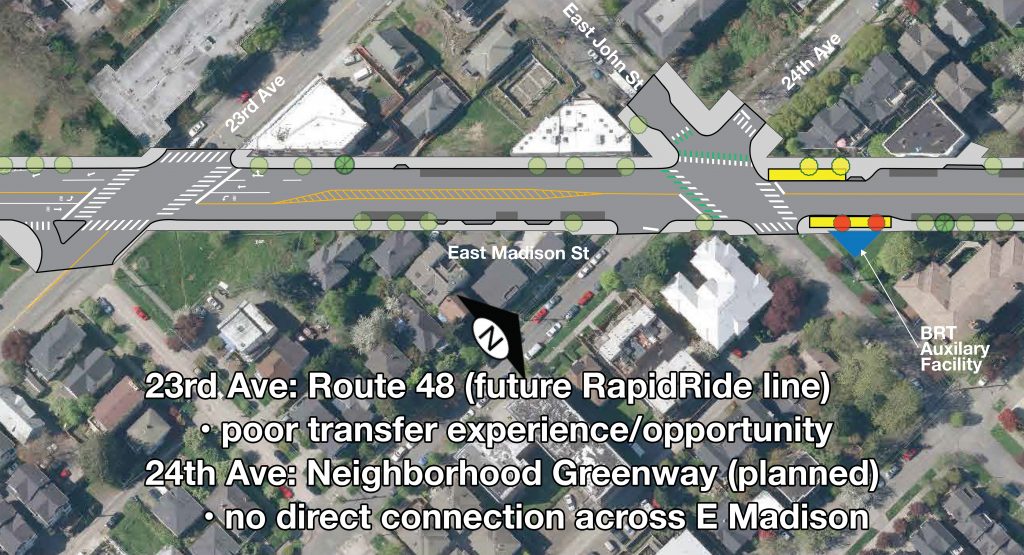
Additionally, though it’s not a safety issue, the location of the bus stops at the east side of the intersection of E Madison St and E John St might prove problematic. Route 48, which operates on 23rd Ave E, is scheduled for transition to RapidRide+ service by 2024. For both of these lines to be useful, the stops should be located as close as possible in order to have a high-quality transfer experience. While it is true that the King County Metro Route 8 will be able to use this stop, the utility of connecting with the 8 is of less value than gained by a high-quality connection to the 48 or its future RapidRide replacement service.
The ability to make a safe, quick, reliable transfer between RapidRide lines at 23rd Ave E must outweigh other uses such as on-street car storage.
E Madison & 12th Ave E
The intersection of E Madison St and 12th Ave E is potentially very dangerous. Located next to Seattle Academy, down the street from Seattle University and near a number of restaurants and bars, it is comprised of two arterial streets and E Union St, which crosses at an oblique angle to Madison St.
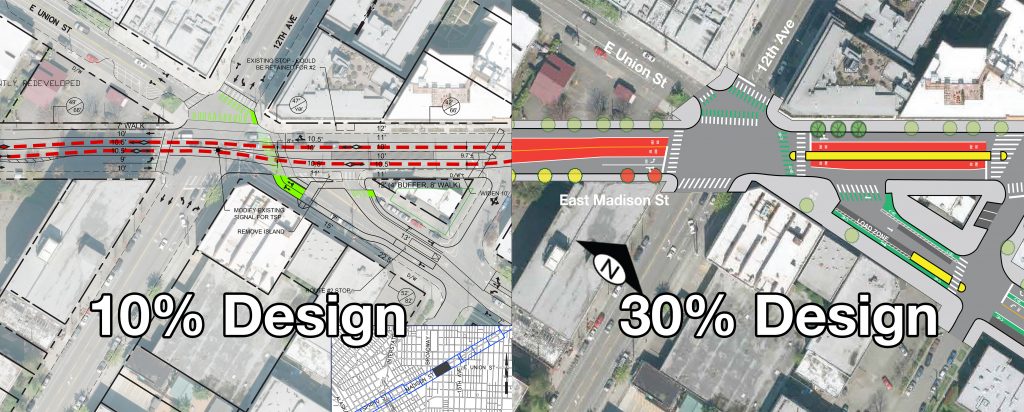
After lengthy discussions with Seattle Greenways, other local neighborhood groups, and the general public, a design was selected that would turn the existing street into a cycletrack and move vehicular access farther east, closer to Pony, the bar that is located in the triangle between E Madison St, E Union St, and 13th Ave E. This would require drivers to make a much safer, slower, deliberate turn onto E Union St. This has been scaled back in the 30% design plans, with the bike route now sharing space with pedestrians on the sidewalk.
The rationale for not keeping with the planned design has to do with the ability of the Route 2 buses to safely negotiate the turn, which is an important consideration. However, a number of people have suggested that SDOT work with the owners of Pony, who are allegedly planning on rebuilding, to relocate the building so that the original design, or something close, might be implemented in a manner that benefits all users of this intersection.
While this might slightly increase the cost of the project at this location, the benefits gained along the life of this project would more than outweigh the negative cost implications.
Mixed Traffic Operations
SDOT is planning on utilizing three types of right-of-way treatments along the 2.4-mile bus corridor:
| 60% | Transit-Exclusive Lanes | Restricted to buses/emergency vehicles | painted red with “bus only” stencils & signage |
| 4% | BAT Lanes | Restricted to buses/vehicles making turns | striped red & appropriately signed |
| 36% | Mixed Traffic | All lanes open to all vehicles | current conditions on Madison |
In general, operations in mixed traffic have the potential to negatively affect reliability and schedules. The buses in this portion of the route will not have the ability to bypass congestion–this is how they operate today–which is one of the primary justifications for this project.
SDOT has stated, however, that their traffic analysis for Madison Valley portion of the route does not have significant issues at this time. They state that the potential benefit gained is negligible, while the expenses of rebuilding intersections and the general roadway are not. SDOT has mentioned that the curb lanes along this portion have the potential to be turned into BAT lanes at a later date if the need is justified, but not to the same level as First Hill (without significant investment).
The Madison RapidRide+ project is by no means perfect. It is trying to solve the errors of decades of auto-centric planning on a critical over-congested route that serves some of the densest neighborhoods in the city as well as multiple major institutions including hospitals and a university. In addition, the design of Madison Street makes it impossible to include bike facilities on Madison itself. As Madison runs at an angle to the street grid, there is also no existing parallel street on which bike facilities may be placed. This will require an inefficient stair-step design using neighborhood streets that will also require a major investment in improvements to that right of way.
While it is clear that SDOT has worked hard to maximize the benefits in the most critical areas of the route, there are still a number of major issues that must be addressed before the design proceeds too far forward. That being said, the project team has proven that they are willing to listen and appear to be interested in alternative design possibilities.
It would be helpful for people to submit feedback to the project team, focusing on the following items:
- Be creative when solving the issues associated with the intersection of E Madison St, E Union St, and 12th Ave E.
- Add crosswalks for people on foot and on bike across Madison on 24th Ave E so that the forthcoming neighborhood greenway is functional and safe for all users.
- Let Metro and SDOT know that you support onboard bicycle racks. This is an important amenity that will dramatically increase safety and decrease dwell time at stations.
- Let SDOT and the Seattle City Council Sustainability and Transportation Committee know that you support the Spring Street transit improvements that can be made now.
Comments and suggestions may be left at the online open house at https://madisonbrt.participate.online, via email at MadisonBRT@seattle.gov, or by calling Emily Reardon, Public Information Officer, at 206.615.1485. Those interested in commenting in person can also attend the public open house tonight (August 9th) from 5pm to 7 pm at the Meredith Mathews East Madison YMCA.
Disclosure: Gordon is the Transportation Committee Chair for the First Hill Improvement Association (FHIA) and has been working with SDOT on this project for a number of years. While FHIA fully supports this project and agrees with the sentiment contained herein, this post should not be construed as an official opinion of FHIA, its board, or committee members.
Gordon Werner
Gordon is a native New Yorker who wisely chose to leave the Northeast in the early 1990s. A past resident of Belltown, and Queen Anne, he currently calls First Hill home. He is a board member of the First Hill Improvement Association (FHIA) as well as the FHIA Transportation Committee Chair and is constantly looking for ways to improve transportation up the hill.


